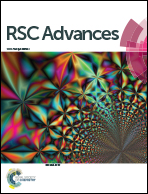Synthesis and characterization of diphenylcarbazide-siliceous mesocellular foam and its application as a novel mesoporous sorbent for preconcentration and trace detection of copper and cadmium ions†
Abstract
We are introducing diphenylcarbazide functionalized siliceous mesocellular foam as a novel mesoporous solid-phase for the extraction of heavy metal ions including copper(II) and cadmium(II). The synthesized mesoporous sorbent was characterized using Fourier transform infrared spectrometry, scanning electron microscopy, elemental analysis, nitrogen adsorption–desorption isotherms and thermal analysis. Determination of the extracted ions was performed by flame atomic absorption spectrophotometry. Effects of pH value, adsorption and desorption time, type, concentration and volume of the eluent, breakthrough volume, and effect of potentially interfering ions were studied. Under optimized conditions, the extraction efficiency is >98%, and the limits of detection are 0.1, and 0.04 μg L−1 for the ions of copper and cadmium, respectively, and the adsorption capacities for these ions are 160 and 190 mg g−1. The obtained data for adsorption capacity of the sorbent shows the high tendency of the sorbent toward the mentioned target ions. Finally, this sorbent can be used as a simple, rapid, reliable, selective and sensitive method for the determination of trace levels of copper(II) and cadmium(II) in different water samples.


 Please wait while we load your content...
Please wait while we load your content...